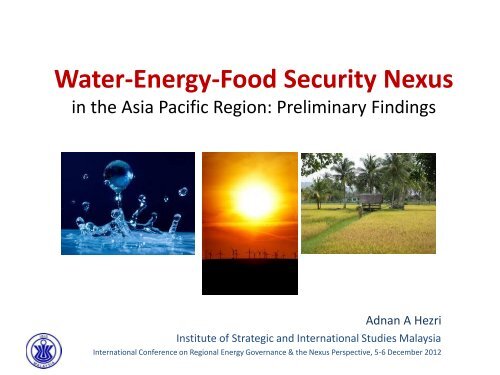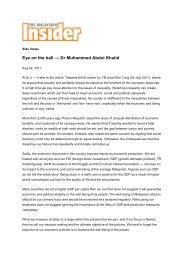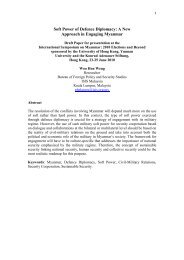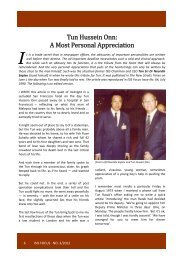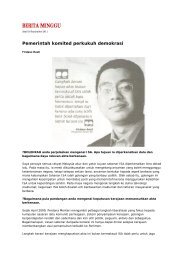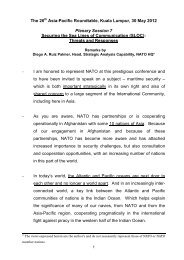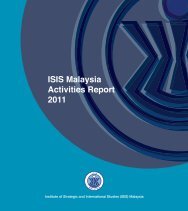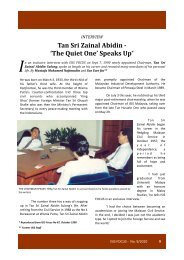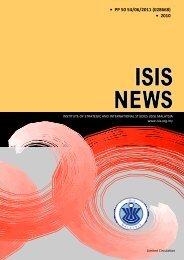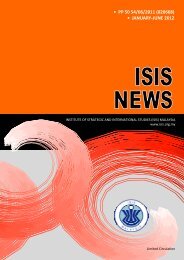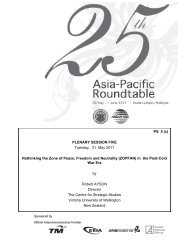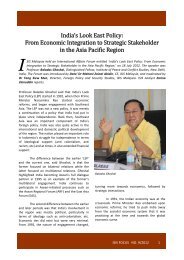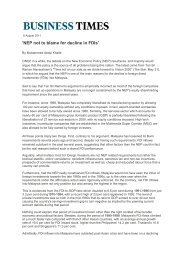Water-Energy-Food Security Nexus - ISIS Malaysia
Water-Energy-Food Security Nexus - ISIS Malaysia
Water-Energy-Food Security Nexus - ISIS Malaysia
You also want an ePaper? Increase the reach of your titles
YUMPU automatically turns print PDFs into web optimized ePapers that Google loves.
<strong>Water</strong>-<strong>Energy</strong>-<strong>Food</strong> <strong>Security</strong> <strong>Nexus</strong><br />
in the Asia Pacific Region: Preliminary Findings<br />
Adnan A Hezri<br />
Institute of Strategic and International Studies <strong>Malaysia</strong><br />
International Conference on Regional <strong>Energy</strong> Governance & the <strong>Nexus</strong> Perspective, 5-6 December 2012
Presentation outline<br />
1. Sustainability and green economy strategies<br />
2. Global resource scramble and the W-E-F nexus<br />
3. <strong>Nexus</strong> flashpoints in the Asia Pacific region<br />
4. Applications of the nexus approach<br />
5. Redefining resource scarcity + future work<br />
6. Concluding remarks<br />
Acknowledgment: This work is funded by the United Nations Economic<br />
and Social Commission for Asia and the Pacific (UNESCAP)
Section 1: Background<br />
SUSTAINABLE DEVELOPMENT AND<br />
GREEN ECONOMY STRATEGIES
UNESCAP Green Growth<br />
Low Carbon Green Growth<br />
Roadmap for Asia and the Pacific<br />
• Launched by UNESCAP in May 2012<br />
• A smart strategy for sustainable<br />
development and a process for arriving<br />
at a green economy<br />
• “Policy option and practical strategies<br />
must take into account resource<br />
constraints and the climate crisis, to<br />
convert crisis of shrinking natural<br />
resources and climate change to a driver<br />
of sustainable and inclusive economic<br />
growth”
Evolution of sustainable development
Green economy strategies for sustainability<br />
Challenges<br />
Solutions<br />
Objective<br />
Business and<br />
the<br />
Environment<br />
Green Job<br />
Green<br />
Financing<br />
Eco-business<br />
Carbon<br />
Trading<br />
Natural<br />
Resource<br />
Management<br />
Natural<br />
Assets<br />
Investment<br />
Green<br />
Agriculture<br />
Revolution<br />
Eco-tourism<br />
Environmental<br />
Pollution<br />
Control<br />
Green<br />
Technology<br />
Green<br />
Innovation<br />
Waste-to-<br />
Wealth<br />
Green City<br />
Securitization of natural resources management?
Section 2: The Global Resource Scramble and<br />
THE WATER-ENERGY-FOOD SECURITY<br />
NEXUS
Resources<br />
running out?<br />
Again?<br />
Today, resources are high<br />
priority concerns in all levels<br />
of government, corporate<br />
boardrooms, and local<br />
communities.<br />
3F crisis - fears about<br />
resources prices and access<br />
are back in vogue.<br />
Beyond the physical scarcity<br />
of single natural resources<br />
Multiple resources, multiple<br />
scarcities? Connections?
The ‘new’ resource scramble?<br />
• Combination of factors causing the new<br />
resource scramble:<br />
– a lack of unexplored resource preserves beyond those<br />
now being used for development;<br />
– the sudden emergence of rapacious new consumers<br />
– technical and environmental limitations on the<br />
exploitation of new deposits;<br />
– rising resource nationalism; and<br />
– the devastating effects of climate change.
<strong>Energy</strong>, water and food resources<br />
<strong>Energy</strong>, water and food are inextricably linked<br />
- <strong>Water</strong> for energy currently<br />
amounts to about 8% of<br />
global water withdrawals<br />
(45% in industrialized countries,<br />
e.g. in Europe).<br />
- <strong>Food</strong> production and<br />
supply chain is<br />
responsible for around 30%<br />
of total global energy<br />
demand<br />
- <strong>Food</strong> production is the<br />
largest user of water at the<br />
global level, responsible for<br />
80–90% of consumptive<br />
blue water use
The <strong>Nexus</strong> Approach<br />
Recognizes interconnectedness of water, energy, and food across space and time. Its<br />
objectives are:<br />
• Improve energy, water, and food security<br />
• Address externality across sectors, and decision-making at the nexus<br />
• Support transition to sustainability<br />
Projections for 2050 with 9.2<br />
billion people:<br />
- 70% increase in agricultural<br />
demand for food by 2050<br />
- 40% energy demand increase by<br />
2050<br />
- But by 2030: confronting water<br />
supply shortage of ~ 40%
Why these three resources?<br />
…unsustainable<br />
pressures on these 3<br />
strategic resources<br />
Source: Adapted from Bazilian et al 2011<br />
Recognize the<br />
consequences of one<br />
sector on another to<br />
achieve efficiency<br />
using systems<br />
thinking
<strong>Water</strong> stress around the globe<br />
A single resource analysis – productivity and availability<br />
of water vary between regions
Geographical hot spots for water-food nexus<br />
Source: FAO<br />
Highlighting risks associated with main agricultural production<br />
systems and interactions across the nexus (i.e.<br />
interdependence between water & food)
International attention on <strong>Nexus</strong><br />
Policy conferences<br />
• 2011 World Economic Forum, Davos<br />
• The Bonn Perspective on Rio+20, 2011<br />
• Ministerial Roundtable ‘W-E-F <strong>Security</strong> <strong>Nexus</strong>, Marseilles<br />
• <strong>Water</strong> Summit 2013 Abu Dhabi: Bringing WEF <strong>Nexus</strong> to Life<br />
Academic conferences<br />
• ReISource: <strong>Food</strong>-<strong>Energy</strong>-<strong>Water</strong> for All, 2012<br />
• Planet Under Pressure: Climate-<strong>Energy</strong>-<strong>Water</strong>, 2012<br />
Key publications<br />
• WEF’s ‘<strong>Water</strong> <strong>Security</strong>’; McKinsey Global Institute’s ‘Resource Revolution’<br />
• Michael T. Klare The Race for What’s Left; Bringenzu’s ‘Sustainable Resource<br />
Management: Global Trends’
Cross-cutting global risks<br />
<strong>Water</strong>-food-energy nexus<br />
Illegal economy nexus<br />
Macroeconomic imbalances nexus<br />
WEF 2011
ReISource 2012<br />
“…we are nowhere near realizing the full impact of this yet.<br />
We have seen the first indications – rising food prices,<br />
pressure on water supplies, a land grab by some countries<br />
for mining rights and fertile agricultural land, and rising<br />
prices for energy and for key resources such as metals.”<br />
Sir David King<br />
U.K. Former Chief Scientific Adviser<br />
Global fight for natural resources has only just begun<br />
The Guardian
Section 3: The Global Resource Scramble and<br />
NEXUS FLASHPOINTS IN ASIA PACIFIC
<strong>Nexus</strong> redefining geopolitics?<br />
Inter-state and<br />
intra-state tension<br />
New resource<br />
geopolitics caused<br />
by governance<br />
failures not<br />
distribution?
Resource challenge in Asia and the Pacific<br />
Since the 1990s, the region has been characterized by rapid<br />
urbanization, large investments in infrastructure development, and by<br />
the emergence of new consumers<br />
<strong>Water</strong> security<br />
• 635 million people lack access to safe water & 1.9 billion lack access to<br />
effective sanitation<br />
<strong>Energy</strong> security<br />
• Growth of energy use in the Asia-Pacific region, particularly in China,<br />
will have major consequences for geopolitics, financial and energy<br />
markets and pollution both regionally and globally<br />
<strong>Food</strong> insecurity<br />
• The global economic crisis and the food crisis in 2006-08, have deprived<br />
an additional 100 million people of access to adequate food
<strong>Nexus</strong> interdependence<br />
Biofuel<br />
• Cultivation of<br />
biomass led to<br />
increased usage<br />
of freshwater<br />
• Increase in water<br />
stress in<br />
countries that<br />
are already facing<br />
water shortages<br />
• Areal<br />
requirements<br />
Hydropower<br />
• Hydropower<br />
generation meets<br />
16% of the<br />
world’s electricity<br />
needs<br />
• construction of<br />
45,000 large<br />
dams<br />
• Social and<br />
environmental<br />
issues abound<br />
Irrigation<br />
• Irrigation<br />
accounts for<br />
about 15–20%<br />
total electricity<br />
use (India)<br />
• Pumping aquifers<br />
faster than they<br />
can be<br />
replenished,<br />
taxing the<br />
electricity grid
<strong>Nexus</strong> Flashpoints<br />
<strong>Water</strong> resources, irrigation and hydro<br />
energy in Central Asia<br />
• Overexploitation of the Syr Darya and<br />
Amu Darya rivers over the past halfcentury<br />
has led to the drying out of the<br />
Aral<br />
• Conflicts between hydropower and<br />
downstream uses, including irrigation<br />
(cotton, rice, wheat), ecosystems<br />
protection and sustainable fishing<br />
• Kyrgyz Republic releases water in the<br />
winter time to generate electricity<br />
• Uzbekistan, Turkmenistan and South Kazakhstan need water in the summer for their<br />
irrigation schemes.
<strong>Nexus</strong> Flashpoints<br />
<strong>Energy</strong> and food security in the<br />
Greater Mekong sub-region<br />
• Cambodia, China, Laos, Myanmar,<br />
Thailand and Vietnam aim to<br />
enhance sub- regional energyeconomic<br />
cooperation<br />
• 11 hydropower dams on the free<br />
flowing main stem of the lower<br />
Mekong River and 77 other dams in<br />
the Mekong Basin as a whole<br />
• will reduce fish catch and place<br />
heightened demands on the<br />
resources necessary to replace lost<br />
protein and calories
<strong>Nexus</strong> Flashpoints<br />
India’s Gujarat groundwater<br />
overdraft impacting on energy<br />
generation<br />
• India’s irrigation sector is<br />
dependent on groundwater<br />
• Much of this groundwater is<br />
pumped using electricity<br />
• Groundwater use is more than<br />
sustainable recharge leading to<br />
groundwater over-exploitation<br />
• <strong>Energy</strong> subsidies caused<br />
groundwater overdraft for<br />
irrigation , causing a nexus<br />
• bankrupted GCB electricity utility<br />
and depleted aquifers especially<br />
since the late 1980s<br />
Districts depicted in red and yellow are the districts with<br />
over-exploitation problems
<strong>Nexus</strong> Flashpoints → integrated solutions<br />
<strong>Food</strong><br />
<strong>Water</strong><br />
<strong>Energy</strong><br />
Source: Aditi Mukherjee, 2012
<strong>Nexus</strong> Flashpoints<br />
China’s ‘Great South-North <strong>Water</strong><br />
Diversion Project’ to dam<br />
Brahmaputra river and channel it<br />
North<br />
• Likely to dry up several streams<br />
in NE India and Bangladesh<br />
• Will affecs rice paddy cultivation<br />
on the Assam floodplain<br />
• May worsen Bangladesh’s food<br />
insecurity problem<br />
• Increase salinity in the delta will<br />
impact the Forest of Sundari<br />
Trees (UNESCO Heritage)<br />
China plans to construct at the Great Bend a dam twice the<br />
size of the Three Gorges Dam
<strong>Nexus</strong> Flashpoints<br />
Dam development in Papua New Guinea<br />
• Purari Development Association acquired a land lease of<br />
650,000 ha<br />
• Construct giant 1800 MW that would flood much of the valley<br />
of River Purari, a sacred ancestral land and sago planting area<br />
• Send power by 500km cable across the Coral Sea to Weipa,<br />
Mt Isa and Townsville in Queensland, Australia<br />
South Korea’s foreign agricultural investment<br />
• One of the world’s biggest food importers<br />
• 2009, Korea Times reported 73 Korean companies were<br />
growing grain on 23,000 ha in 18 countries<br />
• <strong>Food</strong> giant Daesang grows 13,000 ha of maize in Cambodia for<br />
shipping back to Korea
<strong>Nexus</strong> Flashpoints<br />
AUSTRALIA - Droughts in the past decade have left big players bankrupt and selling up.<br />
45 million ha of Australian land ceased production. New acquisition include:<br />
• Australian Agricultural Company sold controlling interest to Dubai’s food & fat<br />
giant IFFCO and <strong>Malaysia</strong>’s FELDA<br />
• Consolidated Pastures 5.7 million ha of NT grassland was sold to British Terra<br />
Firma, a private equity firm<br />
• Canadian company Agrium owns the Australian Wheat Board now named Agrium<br />
Asia Pacific limited<br />
• Singapore’s Wilmar is buying into Queensland sugar; Olam bought 9,000 ha<br />
almond orchards , delivering half of Australia’s almond harvest<br />
• San Diego’s Summit Global Management spent $20 million buying up water<br />
licences in Murray Basin<br />
NEW ZEALAND<br />
• Shanghai Pengxin Group bought 16 farms on North Island from Crafar Farms<br />
Responses<br />
• Sydney Morning Herald – “Australians are in danger of becoming servants and not<br />
masters of their own food resources”<br />
• a sense of siege reflected in public outcry
Section 4:<br />
APPLICATIONS OF THE NEXUS<br />
PERSPECTIVE
What nexus literature tells (1)<br />
1. Input output relationship accounting : nexus characterized in<br />
resource efficiency terms<br />
– China’s wind energy consumes 0.64l/kWh of water and produces<br />
69.9g/kWhh of CO2 emission. Wind power could contribute to 23%<br />
of carbon intensity reduction, saving 800 million m3, sufficient for<br />
use by 11.2 million households (Li et al, 2012)<br />
– Quantitative information about water withdrawal, consumption and<br />
wastewater drainage at each stage of coal supply chain in China (Pan<br />
et al 2011)<br />
– In Texas, 595000 megalitres of water annually (enough for 3 million<br />
people for a year) consumed by cooling thermoelectric power plants<br />
(Stillwell et al, 2011).
What nexus literature tells (2)<br />
2. Analysis of institutional and policy dimensions of resourcecoupling<br />
– cost, price, polycentric governance<br />
– Dramatic increase in costs of energy led to decreased domestic water<br />
access in Alaska’s Northwest, with adverse effects on household<br />
hygiene practices (Eichelberger 2010)<br />
– Low increase in diesel prices over the last few years has resulted in<br />
economic scarcity of groundwater, causing negative impacts on crop<br />
production and farm incomes in the eastern Indo-Gangetic basin,<br />
West Bengal (Mukherje, 2007)<br />
– Multi-tiered institutional arrangements and resource governance –<br />
laws, policies and organizations that operate across jurisdictional<br />
levels for management of resources (Scott et al 2011)
What nexus literature tells (3)<br />
3. <strong>Nexus</strong> policy options – target synergies and avoid potential<br />
tensions<br />
– Create institutions to administer and research nexus issues and share<br />
the findings<br />
• <strong>Energy</strong> and <strong>Water</strong> Research Integration Act, USA (formulated but not approved)<br />
• Opportunities for synergy – carbon sequestration through wetlands conservation;<br />
energy generation from sewage; EE in water services; restoration of floodplains<br />
– Develop technologies to build water, energy, and food infrastructure<br />
• Promote technologies that exploit the potential for more efficient, cost-effective,<br />
and local close-loop solutions based on lifecycle analysis<br />
– Create incentives (and sanctions) to private, public, and civil society<br />
to accelerate theses goals<br />
• increase agricultural power tariffs; limit new power connections for groundwater<br />
wells
Section 5:<br />
REDEFINING RESOURCES SCARCITY<br />
WITH THE NEXUS
New resource realism?<br />
• Problem redefinition guided by the nexus thinking:<br />
– Resource problem was mainly a local (or national), but in recent years,<br />
problems crossing boundary had scaled up, involving supply-chain<br />
concerns<br />
– Scarcity-conflict thesis is gaining currency, but this time at systemic<br />
level (supply-chain; polycentric governance)<br />
– Focusing on the interdependence – understanding the challenges and<br />
finding opportunities<br />
– Countries without supply of virtual water will be vulnerable to market<br />
forces<br />
• Ongoing work for UNESCAP:<br />
– Identify supply-chain shocks and the ensuing policy responses<br />
– Highlight not only inter-state tension but also intra-state nexus issues
Situating the nexus approach<br />
The <strong>Nexus</strong> Approach recognizes interconnectedness of water, energy, and food<br />
across space and time. Its objectives are:<br />
• Improve energy, water, and food security<br />
• Address externality across sectors, and decision-making at the nexus<br />
• Support transition to sustainability
Concluding remarks<br />
<strong>Nexus</strong> as a new resource framing<br />
• Resource securitization involving supply chain concerns<br />
• Current nexus framing focuses on input-output<br />
analysis, less on solutions; a good understanding of<br />
what the problems are<br />
• Asia needs preventive diplomacy to avert conflicts<br />
Moving forward: beyond nexus accounting<br />
• Adopt green economy + growth<br />
• Reorientate government policy framework<br />
• Empower a policy process accommodating<br />
‘institutional’ and systemic thinking


